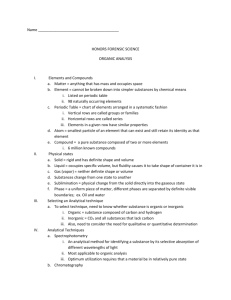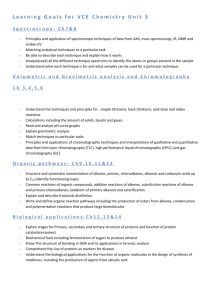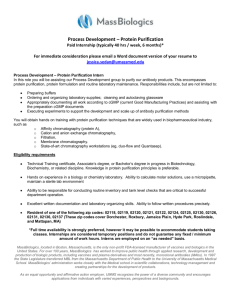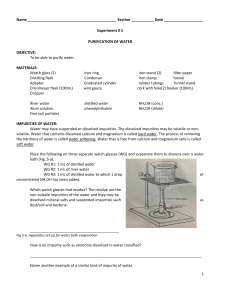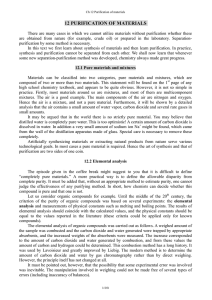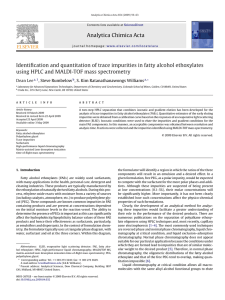434- Part IV [Lec-4
advertisement
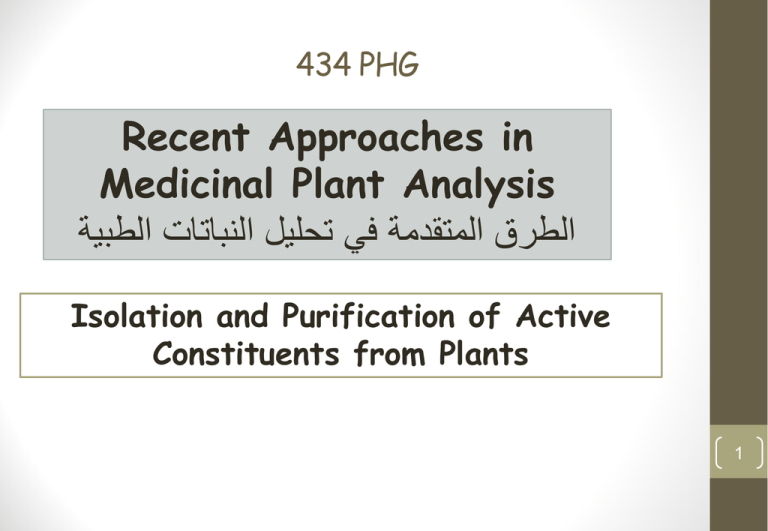
434 PHG Recent Approaches in Medicinal Plant Analysis الطرق المتقدمة في تحليل النباتات الطبية Isolation and Purification of Active Constituents from Plants 1 Purification of secondary metabolites 2 Purification of secondary metabolites (Organic Compounds) Compounds obtained from natural sources or from reaction mixtures almost always contain impurities. The impurities may include some combination of insoluble, soluble, and colored impurities. To obtain a pure compound these impurities must be removed. Each is removed in a separate step. 3 Techniques Used for Purification of Organic Compounds • These techniques include: 1. Filtration 2. 3. 4. 5. 6. Centrifugation Recrystallizationالتبلور (أو البَ ْل َو َرة Differential Solvent extraction Fractional distillation Chromatographic techniques The selection of a proper technique depends on the particular differences in physical properties of the substances present in the mixture 4 1. Filtration 5 2. Centrifugation 3. Recrystallization Separate materials of different densities 6 4. Differential Solvent extraction • Used to extract pure organic compounds from their aqueous solution by shaking with suitable organic solvent in which they are highly soluble. • Non-aqueous solvents (e.g. CHCl3 and diethyl ether) can be used to extract organic products • Eg. Atropin alkaloidal base from its aqueous solution using CHCl3 or CH2Cl2. Successive extraction 7 5. Fractional Distillation 8 Fractional Distillation 6. Chromatography •Based on selective adsorption or partition between stationary and mobile phase. • Column Chromatographybased on adsorption, and used for bulk quantities. • Thin layer Chromatographybased on adsorption, and used for quantitative and qualitative analysis. •Paper Chromatography• based on partition and used for quantitative and qualitative analysis. Gas Chromatography• used to separate and analyse volatile organic liquids. High performance liquids Chromatography (HPLC)- used for qualitative and quantitative analysis of organic compounds. 9 Terminology • Mobile phase: phase which sample is dissolved in may be gas, liquid, or supercritical fluid. • Stationary phase: phase which mobile phase is forced through. • Mobile and stationary phases are chosen so the analyte will distribute itself between the two phases. Adsorbent: finely divided homogenous solid having uniform particle size and large surface area which is capable of attracting molecules to its surface. Chromatogram: a record at the end of chromatographic separation. Development: description of the process of chr. (running of the mobile phase through the stationary phase). 10 Terminology • Retention volume: volume of mobile phase required to elute a particular solute • Tailing: disadvantage of chromatography and solute is eluted in several fraction • Visualization: making the colourless bands visible • partition coefficient: Conc. of the component in the St. Phase K= Conc. of the component in the Mob. Phase • The greater the value of K, the greater the affinity of the compound for a particular stationary phase. N = L / H N: number of theoretical plates Efficiency of a column goes up as N increases and H decreases Typical 250 – 10,000 plates 11 Illustrative problem A mixture of benzene and aniline can be separated by (a) alcohol (b) NaOH (c) HCl (d) Hot water Solution Amines are basic in nature. Therefore, aniline reacts with HCl to form a salt which dissolves in water. Hence, aniline can be separated from benzene by using HCl. Hence, answer is (c). 12 Illustrative problem The most suitable method for the separation of mixture of ortho and para nitrophenol in the ratio of 1:1 is (a) distillation (b) crystallization (c) vaporization (d) colour spectrum The boiling point of o-nitrophenol is 210oC and that of p-nitrophenol is 245oC. Solution Therefore, vapours of o-nitrophenol will be formed first (lower boiling point) and collected seperately and vapours of p-nitrophenol will be formed latter. Hence, answer is (a). 13



